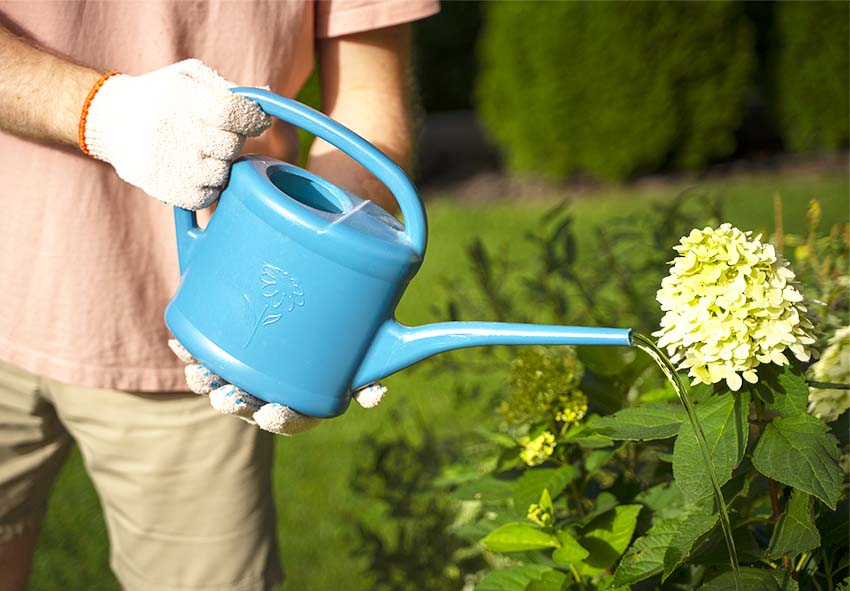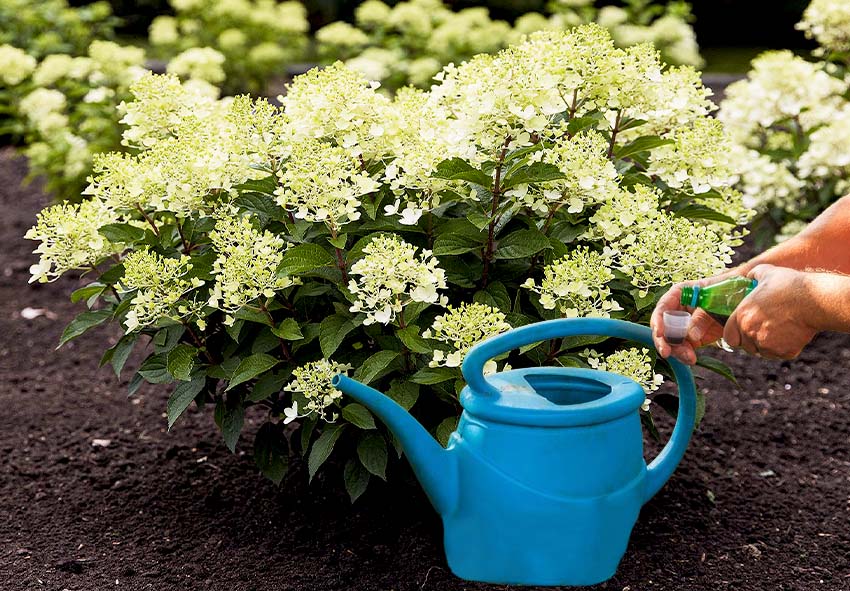Hydrangeas are beloved by gardeners for their stunning blooms and vibrant colors, making them a popular choice in gardens worldwide. To achieve the best results with hydrangeas, it’s essential to understand their hydration and nutritional needs. This guide will cover the key aspects of watering, feeding, and general care tips to keep your hydrangeas thriving. Find more information on our gardening blog.
Hydration Needs for Hydrangeas
Proper hydration is crucial for the health and vitality of hydrangeas. Understanding the right watering practices can make a significant difference in their growth and blooming.
Importance of Proper Watering
Hydrangeas require consistent moisture to maintain their lush foliage and prolific blooms. Proper watering helps prevent stress and ensures the plants absorb nutrients efficiently, leading to vigorous growth and vibrant flowers.
How Often to Water Hydrangeas
The frequency of watering hydrangeas depends on various factors, including climate, soil type, and the plant’s growth stage. Generally, hydrangeas need to be watered deeply once or twice a week. During hot, dry periods, they may require more frequent watering.
Best Watering Techniques

Effective watering techniques ensure even moisture distribution around the root zone. Here are some tips for you:
- Water at the Base: Water hydrangeas at the base to avoid wetting the leaves, which can lead to fungal diseases.
- Use Drip Irrigation or Soaker Hoses: These methods provide a steady supply of water directly to the roots, ensuring even moisture distribution.
- Deep Watering: Water deeply but less frequently to encourage deep root growth and improve drought resistance.
- Morning Watering: Water hydrangeas in the morning to reduce evaporation and allow the foliage to dry before evening, reducing the risk of diseases.
Signs of Overwatering and Underwatering
Recognizing the signs of overwatering and underwatering can help you adjust your watering practices. Overwatered hydrangeas may exhibit yellowing leaves, root rot, and poor growth. Underwatered plants often have wilting leaves, dry soil, and reduced blooming. Monitoring soil moisture levels and plant appearance will guide you in providing the right amount of water.
Nutrition for Hydrangeas
Proper nutrition is essential for hydrangeas to produce abundant blooms and maintain overall health. It’s also an important part of care for hydrangeas after planting. Providing the right nutrients in the correct amounts will enhance their growth and flowering potential.
Essential Nutrients for Hydrangeas
Hydrangeas require several key nutrients for optimal growth, including nitrogen (N), phosphorus (P), and potassium (K). These macronutrients support various functions such as leaf development, root growth, and flower production. Additionally, micronutrients like iron, magnesium, and calcium are vital for overall plant health.
Choosing the Right Fertilizer
Selecting the right fertilizer for hydrangeas involves understanding their specific nutrient needs. Balanced fertilizers with an N-P-K ratio like 10-10-10 or 12-4-8 are generally suitable. For blue hydrangeas, a fertilizer high in phosphorus and low in nitrogen is recommended to encourage blue blooms.
Fertilization Schedule
A well-timed fertilization schedule ensures hydrangeas receive nutrients throughout the growing season. It’s best to apply fertilizer in early spring as new growth begins and again in late spring or early summer. Avoid fertilizing late in the season to prevent new growth that may not harden off before winter.
How to Apply Fertilizer

Applying fertilizer correctly helps prevent nutrient runoff and ensures the roots absorb the nutrients effectively. Here are some main recommendations:
- Read the Instructions: Always read and follow the instructions on the fertilizer package for the correct dosage and application method.
- Apply in Early Spring: Start fertilizing hydrangeas in early spring as new growth begins.
- Distribute Evenly: Sprinkle the fertilizer evenly around the base of the plant, avoiding direct contact with the stems.
- Water Thoroughly: After applying the fertilizer, water the plant thoroughly to help the nutrients penetrate the soil and reach the roots.
- Repeat as Needed: Depending on the type of fertilizer, reapply according to the recommended schedule, typically every 4-6 weeks during the growing season.
Additional Care Tips for Hydrangeas
Beyond watering and fertilizing, several other care practices contribute to the overall health and beauty of hydrangeas. You can find more tips and recommendations in a full guide for hydrangeas.
Mulching and Soil Maintenance
Mulching helps retain soil moisture, suppress weeds, and regulate soil temperature. Apply a 2-3 inch layer of organic mulch, such as bark chips or compost, around the base of the hydrangea. Regularly check soil pH, as hydrangeas prefer slightly acidic to neutral soil (pH 5.5-7.0).
Pruning Hydrangeas
Pruning hydrangeas correctly promotes healthy growth and enhances flowering. Pruning time and method depend on the type of hydrangea. For example, prune mophead and lacecap varieties after flowering, while panicle and smooth hydrangeas benefit from early spring pruning.
Protecting Hydrangeas from Pests and Diseases
Hydrangeas can be susceptible to pests such as aphids, spider mites, and scale insects, as well as diseases like powdery mildew and leaf spot. Regular inspection and prompt treatment with insecticidal soap or neem oil can manage pests. Ensure good air circulation and avoid overhead watering to reduce disease risk.
Winter Care for Hydrangeas
Winter protection is crucial for hydrangeas, especially in colder climates. Mulch around the base of the plants to insulate the roots and cover them with burlap or a frost cloth to shield against harsh winter winds. Prune away dead or damaged stems in early spring.
Common Problems and Solutions

Even with proper care, hydrangeas can face common issues. Understanding these problems and their solutions will help you keep your plants healthy and blooming.
- Yellowing Leaves
Yellowing leaves can indicate nutrient deficiencies, overwatering, or poor drainage. Adjusting watering practices, ensuring proper drainage, and applying a balanced fertilizer can address this issue.
- Lack of Blooms
A lack of blooms may result from improper pruning, insufficient sunlight, or nutrient imbalances. Ensure you are pruning at the correct time, provide adequate sunlight, and maintain a regular fertilization schedule to encourage flowering.
- Wilting
Wilting can be caused by underwatering, overwatering, or root damage. Check soil moisture levels and adjust watering accordingly. If root damage is suspected, gently lift the plant to inspect the roots and replant if necessary.
- Changing Flower Colors
Flower color changes in hydrangeas are influenced by soil pH. Acidic soil (pH below 6) typically results in blue flowers, while alkaline soil (pH above 7) produces pink flowers. Adjusting soil pH with amendments like sulfur or lime can help manage flower colors.
Conclusion
By following these hydration and nutrition tips, you can ensure your hydrangeas remain healthy and vibrant. Implementing proper watering, feeding, and general care practices will lead to beautiful blooms and robust growth. Enjoy the stunning display of your hydrangeas as they thrive in your garden.
Frequently Asked Questions (FAQs) about Hydrangeas Hydration and Nutrition
1. How often should I water my hydrangeas?
Hydrangeas typically need to be watered deeply once a week. During hot, dry periods, you may need to water more frequently. It’s important to keep the soil consistently moist but not waterlogged.
2. Can I order Holland hydrangeas from your online store?
Yes, we offer a wide selection of hydrangeas, including some varieties originating from the Netherlands, renowned for their quality and beauty. Our online store Dutch-bulbs.com features a diverse range of hydrangeas.
3. How can I tell if my hydrangeas are overwatered or underwatered?
Overwatered hydrangeas may have yellowing leaves and a droopy appearance. Underwatered hydrangeas will also droop but may have crispy, brown edges on the leaves. Monitoring the soil moisture and adjusting your watering routine can help prevent these issues.
4. When is the best time to fertilize hydrangeas?
The best time to start fertilizing hydrangeas is in early spring as new growth begins. Continue to fertilize every 4-6 weeks during the growing season, stopping in late summer to avoid encouraging new growth that could be damaged by frost.
5. How do I protect my hydrangeas from pests and diseases?
To protect hydrangeas from pests and diseases, regularly inspect the plants for signs of trouble. Use organic pesticides or insecticidal soaps as needed, and ensure proper spacing and air circulation around the plants to prevent fungal issues. Mulching can also help maintain soil moisture and reduce weed growth.
Published: 05.07.2024
